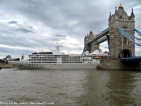





Docklands and the Thames,
Victoria Park to Paternoster
Square. Take a nostalgic
trip back to the East End in
the 1950’s or a stroll around
the Square Mile of the City
of London. It’s all here at
barryoneoff.co.uk
Copyright 2002 - 2024 ©Barry Carter. All rights reserved
TOWER BRIDGE - A LONDON ICON
A flaw in the design
The original design, by Horace Jones, was accepted by the City Corporation,from one of many submissions by other architects. Horace Jones was the architect of many famous buildings, including Leadenhall, Smithfield and Billingsgate markets, the new Temple Bar that replaced Wren’s original and St. Johns Church in my own manor of Bethnal Green. The engineer was his partner, John Wolfe Barry, aided by Henry Marc Brunel. The original plan was for an arched support with a series of cables to lift the two separate bridge leaves, or bascules. This plan was abandoned when it was pointed out that the curve of the arch would prevent the bridge leaves raising to their full extent. Hence the right angled walkways. Unfortunately, Sir Horace never saw the completion of the bridge, as he died a year after the work started. This left John Wolfe Barry to see the job through to it’s completion. The bridge was opened by Edward, Prince of Wales and Alexandra, Princess of Wales in 1894.How it works
The raising of the bridge leaves is achieved by hydraulic power. The machinery is housed inside the wide base of each tower. The original power source working the pumping engines was steam. The electricity produced was stored in six large accumulators (batteries). In 1976 the method was changed to oil and mains electricity to replace steam. All of the original boilers and machinery can still be seen on a visit to the engine rooms.Memorable moments
On the 30th December 1952, a number 78 double decker bus was travelling across Tower Bridge towards East London when the bridge started to open! A less sophisticated system than today was used back then, and a watchman was supposed to ring a bell and close the gates before setting the bridge in motion. On this occasion, for some reason, he neglected to do this. The bus driver, Albert Gunter, had no choice but to accelerate and jump the gap. He successfully landed on the other bascuel, with only one passenger injured and the conductor breaking his leg. The driver collected £10, and given a day off, for his heroic jump. In 1912, Frank McLean flew a seaplane underneath walkways. of Tower Bridge. He then flew under all the Bridges up to Westminster. On the way back, he ended up in the Thames due to the wind. On 5 April 1968, an RAF pilot, Flight Lieutenant Alan Pollock flew a Hawker Hunter jet over the Houses of Parliament then on through Tower Bridge,as a protest at the government. On 13th July 2009, an Australian stuntman, Robbie Maddison, jumped the raised bascules on a motorbike, performing a back-flip before landing on the other side. This took place in the early hours, with permission. In 2012, two helicopters flew through the gap carrying a stunt double of Queen Elizabeth II, for the opening of the 2012 London Olympics.A London Landmark
Tower Bridge is my all time favourite Victorian construction and thoroughly deserves it's grade 1 listing. Considering it's position and age (constructed between 1886 and 1894), it is a marvel of engineering and design. The name comes from it's close proximity to the Tower of London. The bridge consists of two Gothic design towers, one either side of the river Thames, The reason for the classic design was that Queen Victoria did not want a modern style construction adjacent to the Tower of London. The two towers were connected by a horizontal section consisting of two high walkways. These walkways were designed to allow people to cross the bridge while it was being raised. They soon became used by muggers and prostitutes and so were closed in 1909. They were re-opened for the tourist trade many years later and a section now has a glass floor. Below these walkways is the actual road bridge, made in two sections to allow it to open up and allow tall vessels to navigate in and out of what is known as the Pool of London.Traffic on the river
The bridge is frequently opened for a variety of craft, from sailing barges to cruise ships. Tower Bridge has become one of the most recognisable London landmarks and tourists flock to it for a photo, or selfie, using it as a background. It is often confused with London Bridge by some, because of it's grandeur. This has led to the totally untrue urban legend that the Americans bought the wrong bridge when they shipped the old London Bridge to Lake Havasu.





















